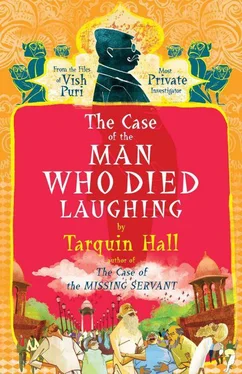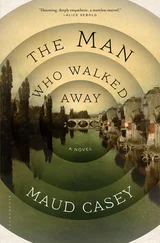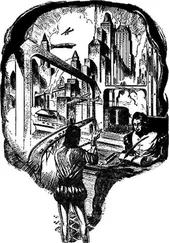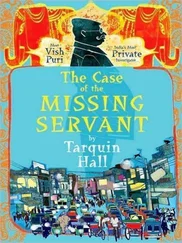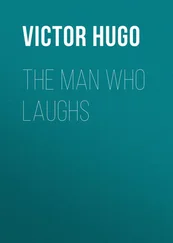Off to the right stood the main reception building and behind this the darshan hall and Maharaj Swami’s residence, where there were only a couple of lights on.
Facecream spent ten minutes under the maple tree making sure that the coast was clear. Then she made her way to the darshan hall, keeping to the shadows and meandering between plinths, benches and trees. She reached a side door that was warped and didn’t close properly and slipped inside the building.
Although the lights were all off and no moonlight filtered in through the stained glass windows, there were still enough candles burning under the effigies for her to see her way up onto the stage.
There, she had to switch on Flush’s pocket-size flashlight in order to search for the trapdoor behind Maharaj Swami’s silver throne she was sure must be there. Facecream soon came across its outline but in the process bumped her head into something hard – a large pane of thin glass about ten feet across and at least twenty feet high suspended on ultrathin wires from the ceiling. Hanging at an angle of forty-five degrees over the trapdoor, it touched the stage at its base.
Puri’s operative felt her way behind the glass and discovered a second, smaller trapdoor. This one had a latch.
It lifted easily to reveal a set of concrete stairs.
At the bottom, Facecream found herself standing at the beginning of a passage.
On one side stood a door.
The room beyond was roughly ten feet square and twenty feet high. Its ceiling was the underside of the larger of the two trapdoors. Now she could see that it was designed to open downward on quiet rubber-lined tracks. A switch on the wall operated a mechanical pulley system like those used on automatic garage doors.
In the middle of the room stood a plinth with a light projector on top of it. The front of the projector was raised up on a block. It was pointing at a wooden platform built against the wall at the back of the room. The platform stood about six feet off the ground and could be reached by a ladder.
On the wall opposite the platform hung a large silvered mirror positioned at an angle of forty-five degrees.
There were only two pieces of furniture in the room: a chair and a dressing table. In a drawer of the latter, she found a rubber mask. Its face was that of a wizened old man with a thick, bulbous nose and pronounced frontal lobes.
Facecream recognized it instantly: it was the rishi oracle.
She spent a few minutes trying to make sense of how the illusion worked and thought she understood. An actor wearing the mask stood on the platform and the light projector was switched on. His brightly lit profile appeared in the silvered mirror and was reflected up to the pane of glass on the stage through the trapdoors, which opened on demand. Somehow – science was not her strong point – this created a ghostlike image. The smoke was an extra touch to make the illusion all the more spectacular.
The room also contained a hydraulic lift, which, according to the instructions on the control panel, could be raised to a height of twenty-five feet. Facecream wondered if perhaps this was the secret behind Maharaj Swami’s levi-tation.
Venturing farther down the damp and musty passage with her flashlight’s feeble beam catching glimpses of the odd rat, she soon came to an intersection. The passage to the left, she guessed, led to the Abode of Tranquility; the one to the right, back to the residence hall. Facecream took neither of these, pressing on through puddles of water, until about a hundred yards farther on, she reached another set of stairs.
These led up to yet another door.
Switching off her flashlight, she pushed it open an inch and peeked through the gap. The room beyond was dark, but she recognized the desk with the computer on top of it by the window and realized with glee that she had found her way into Maharaj Swami’s private audience chamber.
The door was a secret one disguised amongst the bookshelves.
She opened it a little wider so that she could get a better look.
The Venetian blinds were drawn and the only source of light was coming from beneath the main door to the room, which was on her right.
Suddenly she heard male voices and footsteps beyond in the echoey entrance hall and stepped back, pulling the secret door almost shut.
For several minutes she waited, not daring to venture into the room. Finally the voices faded and the light was switched off.
Silence.
Facecream slipped off one of her chappals and lodged it between the door and the wall. Risking her flashlight again, she stole across the room to Maharaj Swami’s desk. Following Flush’s instructions, she turned on the computer and, by holding down the escape key, ensured that it booted up in DOS.
She drew the om pendant from around her neck and pulled it apart to reveal the USB data key inside. This she inserted into one of the computer’s ports, typed the word ‘copy’ and pressed the return key.
The process took only a few minutes. Then she retrieved the key, put it back around her neck and switched off the machine.
Opening the metal door that she had spotted during her private audience with Swami-ji did not prove as easy. The two warded locks were both different, and she had to make subtle alterations to two different skeleton keys in order to get them open.
Finally, however, the second of the locks let out a satisfying click.
Fully fireproofed, windowless and meticulously organized, the room beyond was a veritable Aladdin’s cave – not of jewels and coins but of information.
Manish the Magnificent had been right. Maharaj Swami – Aman in his former incarnation – was an obsessive hoarder. Stacked on the shelves along both walls were boxes and silver metal trunks. The room was an archive of memorabilia collected from an early age.
It read like an autobiography.
All the props the young Aman had used in his teens and early twenties as a traveling street magician were there – dusty old wicker baskets, aluminum swords and a bed of nails. There were bottles of chemicals, some with still legible labels: “Potassium Permanganate’, ‘Glycerine’, ‘Yellow Phosphorous.” And Facecream came across photographs taken of him performing for tourists in front of the Taj Mahal when he was no more than seventeen – skinny, pencil-thin moustache, suit two sizes too small.
Aman had evidently traveled the length and breadth of India. And then, at the age of twenty-seven, he had left the country. In one box marked ‘USA’, she discovered souvenir postcards, ticket stubs, brochures and a crude diary detailing his travels. Far from sitting in a cave attaining nirvana as he claimed to have done, Maharaj Swami had traveled to Las Vegas, where he had won nearly nine thousand dollars on blackjack and watched David Copperfield perform!
“To Aman with love, David,” read the dedication scrawled in marker pen on a glossy headshot of Mr. Copperfield. Attached was the pink flamingo drink stirrer that had dressed the Long Island iced tea he had drunk at Caesars Palace after the show.
From America, Aman had traveled across Europe, Russia and the Far East, seeking out the world’s greatest magicians and working for some of them as an understudy.
Finally, at the age of thirty-four, he had returned to India and dedicated two years to mastering yoga. It was during this period that he had come to meet the man in the black sherwani. His name, according to Aman’s diary from this period, was Vivek Swaroop, and he was a graduate of Harvard Business School. At the time of their first meeting, he had been working for another internationally successful guru in Pune, marketing his books and health products and running his ashram, which catered to Western, spirituality-seeking tourists.
Читать дальше
